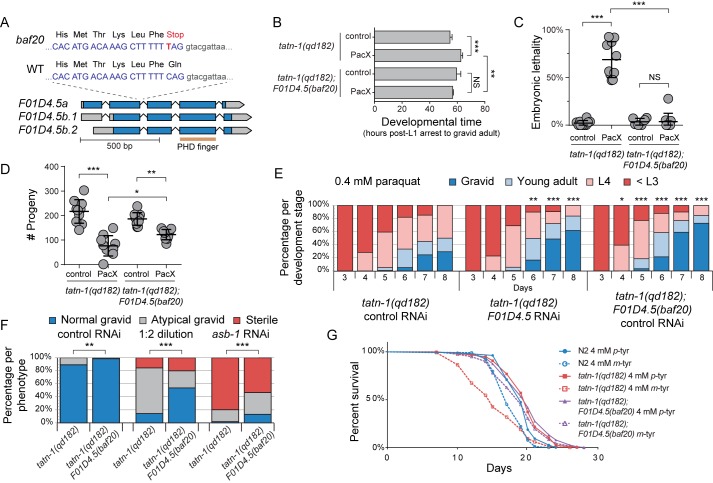Figure 5.
F01D4.5 mutation suppresses the adverse effects of oxidative stress and m-tyrosine treatment in tatn-1 mutant worms. A, diagram depicting the various isoforms F01D4.5, the location of its predicted PHD finger domain, and the nature of the mutation isolated from the EMS mutagenesis screen. B, the F01D4.5 mutation reduces the development time for tatn-1(qd182) mutant worms treated with PacX-expressing bacteria to become gravid adults. Shown are the mean developmental time and S.D. (error bars) for 4–5 worms per genotype-treatment pair to develop from an arrested L1 larvae into a reproductive adult. **, p < 0.01; ***, p < 0.001; NS, nonsignificant by a one-way ANOVA. C, the F01D4.5 mutation suppresses the increased embryonic lethality of tatn-1(qd182) mutants treated with PacX-expressing bacteria. Shown are the mean percentage of embryonic lethality and S.D. from 6–10 worms assayed per genotype-treatment pair. ***, p < 0.001; NS, nonsignificant by a one-way ANOVA. D, results from a fertility assay showing an increase in the number of progeny produced by tatn-1(qd182); F01D4.5(baf20) worms treated with PacX-expressing bacteria. Shown are the mean progeny produced by 9–10 worms assayed per genotype-treatment pair along with the S.D. *, p < 0.05; **, p < 0.01; ***, p < 0.001 by one-way ANOVA. E, either the F01D4.5 mutation or F01D4.5 RNAi reduces the developmental delay produced by treatment with 0.4 mm paraquat, as shown by a developmental assay. Shown are the percentage of worms in the indicated developmental stage on each day with ∼150 worms being scored per genotype and treatment. **, p < 0.01; ***, p < 0.001 for comparison of worms deficient in F01D4.5 as a result of F01D4.5 RNAi treatment or the F01D4.5(baf20) genetic mutation to tatn-1 mutant worms treated with control RNAi of the same age by χ2 test. F, the F01D4.5(baf20) mutation attenuates the sterility resulting from the treatment of tatn-1 mutants with asb-1 RNAi. Approximately 150 worms were scored per genotype and RNAi treatment based on the number of eggs within the uterus of each animal. Shown are the percentage of worms showing each reproductive phenotype with the worms being scored as sterile (zero eggs observed), abnormal gravid (<6 eggs), or normal gravid (≥6 eggs). **, p < 0.01; ***, p < 0.001 for comparison of tatn-1(qd182); F01D4.5(baf20) mutant worms with tatn-1(qd182) worms for each dilution by χ2 test. G, treatment of WT and tatn-1 mutant animals with m-tyrosine reduces worm lifespan, and the F01D4.5 mutation reduces the adverse effect on longevity. Kaplan–Meier survival curves for N2, tatn-1(qd182), and tatn-1(qd182); F01D4.5(baf20) worms on NGA plates supplemented with either 4 mm p- or m-tyrosine. n = 108–122 worms per genotype and treatment. p < 0.0001 for N2 and tatn-1 mutants treated with m-tyrosine versus p-tyrosine, whereas p = 0.06 for tatn-1(qd182); F01D4.5(baf20) treated with m-tyrosine versus p-tyrosine determined by log-rank test. Mean lifespans were as follows: p-tyrosine–treated N2, 19.2 days; m-tyrosine–treated N2, 17.7 days; p-tyrosine–treated tatn-1(qd182), 19.7 days; m-tyrosine–treated tatn-1(qd182), 15.5 days; p-tyrosine–treated tatn-1(qd182); F01D4.5(baf20), 19.9 days; m-tyrosine–treated tatn-1(qd812); F01D4.5(baf20), 18.9 days.

